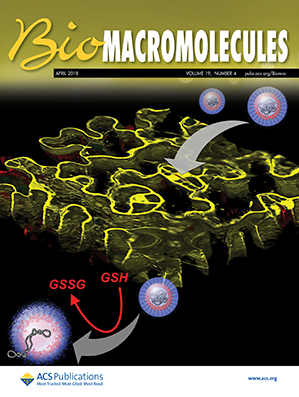生物基单体共聚物结构的抗菌活性。
IF 5.5
2区 化学
Q1 BIOCHEMISTRY & MOLECULAR BIOLOGY
引用次数: 0
摘要
对新型抗菌化合物的迫切需求促使科学家们探索抗菌肽(AMPs)和抗菌聚合物,以解决多药耐药性问题。在本研究中,我们通过自由基聚合(FRP)合成了具有阳离子和疏水分子的共聚物,并使用链转移剂控制分子量。随着单体含量(13-25%)和共聚物分子量(5000-20000 g-mol-1)的变化,我们评估了天然产品作为疏水分子一部分的潜力。疏水性采用理论 Log Poct 值和表面积(SA)进行评估。生物检测包括对大肠杆菌和金黄色葡萄球菌标准菌株的抗菌活性、红细胞(RBC)溶血活性以及对 HEK293T 细胞的细胞毒性测试。关键研究结果表明,具有三苯酮分子、较低分子量以及疏水性和阳离子分子之间最佳平衡的共聚物为未来抗菌剂的开发奠定了良好的基础。本文章由计算机程序翻译,如有差异,请以英文原文为准。
Antimicrobial Activity of Copolymer Structures from Bio-Based Monomers
The urgent need for new antimicrobial compounds has led scientists to explore antimicrobial peptides (AMPs) and antimicrobial polymers as solutions for multidrug resistance. In this study, we synthesized copolymers with cationic and hydrophobic moieties by free-radical polymerization (FRP) using a chain transfer agent to control molecular weights. The potential of natural products as part of the hydrophobic moiety was evaluated, along with variations in their monomer content (13–25%) and the molecular weight (MW) of the copolymer (5000–20,000 g·mol–1). Hydrophobicity was evaluated using the theoretical Log P oct values and surface areas (SAs). Biological assays included antimicrobial activity against Escherichia coli and Staphylococcus aureus standard strains, hemolytic activity in red blood cells (RBC), and cytotoxicity tests against HEK293T cells. Keys findings indicate that copolymers with tropolone moieties, lower MWs, and an optimal balance between hydrophobic and cationic moieties show a promising basis for future generations of antimicrobials.
- Download: Download high-res image (82KB)
- Download: Download full-size image
求助全文
通过发布文献求助,成功后即可免费获取论文全文。
去求助
来源期刊

Biomacromolecules
化学-高分子科学
CiteScore
10.60
自引率
4.80%
发文量
417
审稿时长
1.6 months
期刊介绍:
Biomacromolecules is a leading forum for the dissemination of cutting-edge research at the interface of polymer science and biology. Submissions to Biomacromolecules should contain strong elements of innovation in terms of macromolecular design, synthesis and characterization, or in the application of polymer materials to biology and medicine.
Topics covered by Biomacromolecules include, but are not exclusively limited to: sustainable polymers, polymers based on natural and renewable resources, degradable polymers, polymer conjugates, polymeric drugs, polymers in biocatalysis, biomacromolecular assembly, biomimetic polymers, polymer-biomineral hybrids, biomimetic-polymer processing, polymer recycling, bioactive polymer surfaces, original polymer design for biomedical applications such as immunotherapy, drug delivery, gene delivery, antimicrobial applications, diagnostic imaging and biosensing, polymers in tissue engineering and regenerative medicine, polymeric scaffolds and hydrogels for cell culture and delivery.
 求助内容:
求助内容: 应助结果提醒方式:
应助结果提醒方式:


